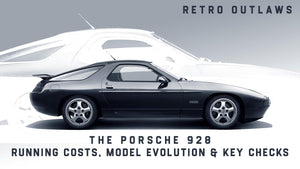The Ultimate Porsche 928 Buyer’s Guide: Running Costs, Model Evolution & Key Checks
In the late 1970s, Porsche decided to shake up its rear-engine lineage by creating a luxurious V8 grand tourer that could compete with BMW and Mercedes. The result was the Porsche 928, a front-engine, water-cooled coupe that pushed design and engineering boundaries—so much so that it won the European Car of the Year title in 1978 (still the only sports car to do so).
Today, the 928’s blend of performance and comfort attracts a devoted following. But like any classic, it’s crucial to understand running costs, potential pitfalls, and how each model evolved over its 18-year lifespan. In this guide, we’ll dive into running costs, key model variations, common inspection points, and the details you need to avoid buyer’s remorse. After all, a well-chosen 928 can deliver a thrilling ownership experience—and look stunning at any car meet or track day.
Check out my 928 race-inspired snapback:

1. Running Costs: Fuel, Servicing & Surprises
Fuel Consumption
-
Thirsty V8: Around town, an S4 model might manage 12–15 mpg, improving slightly to 18–20 mpg on a longer run. Early models and bigger-engine GTS variants also guzzle fuel—it’s the price of that glorious V8.
-
Daily Driver?: If you’re aiming for a more economical classic, a 928 isn’t it. But owners often accept higher fuel costs in exchange for the GT performance.
Oil Usage
-
1 Liter Every 500 Miles: The 928’s V8 can consume oil at a brisk pace. Always keep spare oil on hand to avoid running low and risking engine damage.
Standard Servicing
-
Annual Service: Depending on mileage and condition, expect around £200 (ex. VAT) for a minor service and £600 (ex. VAT) for a major.
-
Older Car “Discoveries”: Each annual service may reveal corroded brake lines, perished engine mounts, or worn electrical components in a 20–40-year-old car.
Belt & Water Pump Changes
-
4-Year or 60k Miles Rule: Budget £1,000–£1,500 (ex. VAT) for replacing the timing belt, water pump, tensioners, and “while you’re there” items. This is non-negotiable maintenance on an interference engine.
Coolant & Brake Fluid
-
Coolant Changes: Every 4 years (with genuine Porsche coolant) to curb internal aluminum corrosion. A failing radiator could cost £900+ plus labor.
-
Brake Fluid: Refresh every 2–4 years, especially if the car sees only occasional use.
Gearbox Health
-
Autos (3- & 4-Speed): Derived from Mercedes, generally reliable but watch for slow, stiff, or jerky shifts indicating pressure or fluid issues.
-
Manuals: Linkage can seize, synchros can wear, and replacements or rebuilds can be costly. Clutches often last 70–80k miles but replacing one may run around £1,000.
Suspension & Bearings
-
Bushings & Bearings: Beyond 100k miles, expect wear. Replacements can be done relatively affordably compared to entire arm assemblies.
-
Shocks: Around £200+ (ex. VAT) each to restore proper handling.
(In short, factor in around £1,500–£2,500 annually for general upkeep, plus a buffer for big-ticket surprises. It’s a classic Porsche, so budgeting is essential.)
2. Model Evolution: Which Porsche 928 Is Right for You?
Over its 18-year run (1977–1995), the 928 saw numerous engine and trim updates. Here’s a concise timeline:
1978–1979: The Original 928
-
4.5L V8, roughly 237–240 hp (even less in U.S. emissions form).
-
Early “telephone dial” wheels; Bosch K-Jetronic injection.
-
Won European Car of the Year in 1978.
1979–1982: 928 S
-
4.7L V8, 295–300 hp.
-
Improved 4-speed automatic; more refined interior.
-
Some limited-edition anniversary models (e.g., Meteor metallic paint, monogrammed seats).
1982–1984: S2 & Anniversary Editions
-
Power edging toward 310 hp, standard power steering.
-
Air conditioning became an option to accommodate driver preferences.
-
Key cosmetic tweaks, bigger brakes, better suspension.
1984–1986: Further Refinements
-
Enhanced 928 S2 with improved brakes, suspension.
-
Not the revolutionary changes seen in later S4, but incremental steps boosting reliability and performance.
1986–1989: 928 S4 & Variants
-
5.0L, 32-valve V8, around 316–320 hp.
-
Dual overhead cams made it an interference engine—timing belt changes crucial.
-
Aerodynamic and styling updates, including a separate rear spoiler.
-
Club Sport (CS), Sport Equipment (SE): Extremely rare, lightweight, performance-oriented spinoffs.
-
928 GT (introduced 1989): 325 hp manual-only; revered among purists.
1990–1995: 928 GTS
-
5.4L V8, up to 345–350 hp.
-
Often considered the ultimate 928, with improved bodywork and advanced tech.
-
Production ended in 1995; final models sold in early 1996.
(The S4, GT, and GTS are typically the most sought after, but early models have a simpler charm and can be cheaper to maintain—just ensure they’re well-kept.)
3. Key Inspection Points: Avoiding Pitfalls
Engine & Cooling
-
Timing Belt: Check service intervals diligently; a snapped belt can destroy valves.
-
Oil Consumption: Expect at least 1 liter per 500 miles in normal use. Billowing smoke on startup could signal a top-end rebuild.
-
Radiator & Coolant Leaks: Corroded rads can cost £900+ to replace, so check for drips and the use of genuine Porsche coolant.
Transmission & Driveshaft
-
Auto: Ensure smooth shifts; watch for fluid leaks from the torque converter or underbody.
-
Manual: Notchy feel is typical, but if it’s excessively stiff or the linkage is seized, you may face a pricey repair.
-
Clutch: Replacements around £1k.
Suspension & Steering
-
Worn Bushes: Check for knocks or rattles. Replacements are cheaper than entire control arms.
-
Bearings & Mounts: High-mileage 928s often need fresh wheel bearings and engine/trans mounts. A slight vibration at idle may indicate worn mounts.
-
Power Steering Leaks: ATF-based fluid is flammable if a pressurized line fails.
Rust & Body Integrity
-
Underside & Joints: Corrosion can lurk near subframe attachments or in coastal-use cars.
-
Aluminum Panels: Doors, wings, bonnet are aluminum; bumpers are polyurethane; the rest is zinc-coated steel. A paint thickness gauge can reveal filler or repaints.
-
Sunroof & Hatch Seals: Water ingress leads to wet carpets or hidden corrosion.
Electrics & Interior
-
Dashboard & Gauges: Age can cause wiring fragility, failing printed circuit boards, or non-functional displays.
-
Pop-Up Headlights: Must raise and lower smoothly.
-
HVAC & Seats: Electric seat adjustments or AC might need attention—parts can be scarce or pricey.
-
Rear Seats & Carpets: Check for dampness, tears, or rotting underlayment from water leaks.
Paperwork & Provenance
-
Service History: Look for records of timing belt, water pump changes, and consistent oil changes.
-
Special Editions: Verify authenticity (e.g., S4 CS, SE, GT). Option codes can be checked via the VIL under the boot carpet.
-
Mileage vs. Maintenance: A well-kept high-miler beats a neglected low-mile 928 every time.
(If in doubt, hire a pre-purchase inspection. A trained eye can save you thousands in unexpected repair bills.)
4. Ownership Insights & Typical Costs
-
Annual Services: ~£200 (minor) to £600 (major), ex. VAT. A 928 often reveals hidden needs each year (fuel lines, brake hoses, etc.).
-
Cam Belt & Water Pump: ~£1,000–£1,500 every 4–5 years or 60k miles.
-
Clutch or Auto Rebuild: ~£1k (clutch), more if the auto requires internal work.
-
Radiator Replacement: ~£900 + labor if corroded.
-
Shock Absorbers: ~£200+ each, ex. VAT.
-
Misc. Surprises: Engine mounts, wheel bearings, steering lines—these can add up, especially on older cars with patchy histories.
All told, a well-maintained 928 can be relatively trouble-free if serviced correctly. But neglect quickly spirals into major bills. Buy the best you can afford; a bargain car typically needs a big infusion of cash.
Check out my Vintage 928 Hoodie

5. Why the 928 Still Matters
-
Iconic Design: Pop-up headlights, muscular haunches, and a cabin that still feels ahead of its time.
-
Balanced Grand Tourer: The Weissach axle offered subtle rear-wheel steering effect, boosting high-speed stability and comfort.
-
Historical Significance: The only sports car to ever win European Car of the Year, plus a near two-decade production run that cemented its place in Porsche lore.
-
Increasing Values: As enthusiasts recognize the 928’s innovation and scarcity (especially for manual, GT, or GTS models), prices are creeping up—meaning a carefully bought example can be a sound investment.
6. Celebrate with Retro Outlaws’ Porsche 928 Apparel
Once you’ve found (or are dreaming about) your perfect 928, there’s no better way to showcase your passion than by wearing gear inspired by this front-engine legend:
-
Porsche 928 Collection – T-shirts, caps, and hoodies that echo the car’s sleek lines and bold stance.
-
928 Vintage Baseball Cap – Ideal for weekend car meets or spirited drives in the country.
-
928 Trucker Cap – Mesh-backed comfort for those hotter track days.
-
928 Vintage T-Shirt – A classic design that captures the 928’s timeless wedge profile.

-
Retro Vintage 928 Hoodie – Comfy, stylish warmth for working under the hood or heading out on a chilly morning cruise.
(Pro Tip: Whether you’re showing off your newly acquired 928 or just a die-hard fan, dressing the part will turn heads at every car club gathering!)
Conclusion
A Porsche 928 is no ordinary classic. Its front-engine V8 layout, futuristic design cues, and rich lineage make it a thrilling yet demanding machine to own. Running costs—including frequent fueling, vigilant servicing, and potential surprise repairs—are part of the package. But for those drawn to its muscular silhouette and grand tourer charm, the investment often feels well worth it.
By focusing on timing belt intervals, electrical health, rust checks, and documented service history, you’ll avoid many of the pitfalls lurking in a neglected 928. And once you’ve secured a well-sorted example, you’ll have a truly unique piece of Porsche history—one that merges everyday comfort with V8 performance in a way that few cars can rival.
Ready to flaunt your 928 obsession? Swing by Retro Outlaws to grab apparel that channels the 928’s spirit—because your look should be as iconic as the grand tourer in your garage. Safe motoring, and welcome to the world of the luxury GT Porsche!


